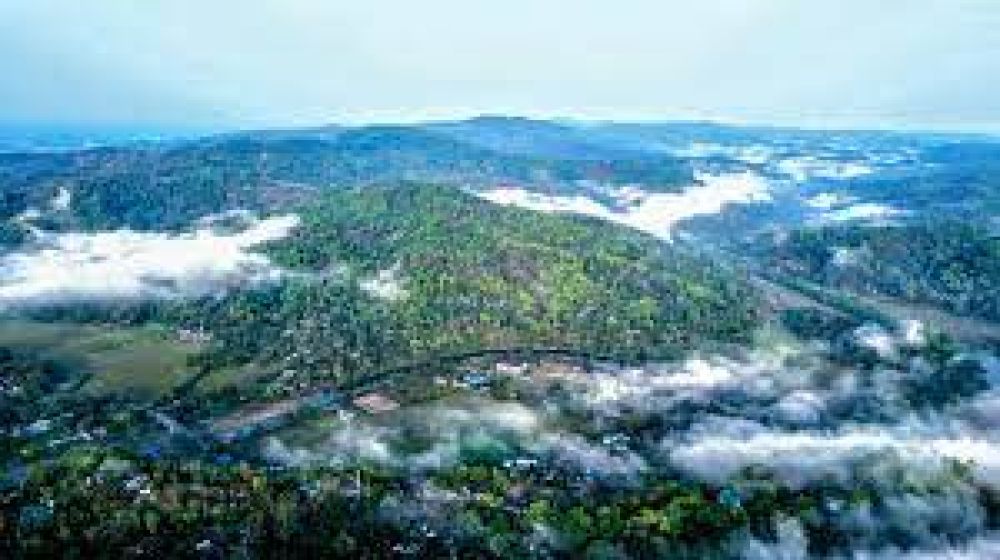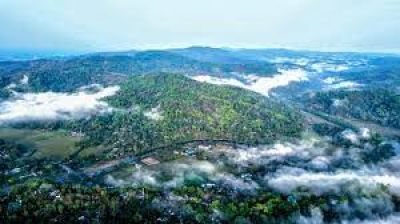

Located at a distance from Baghmara, the Elephant Falls are amongst the most popular tourist attractions in the Meghalaya region. Named by the British due to a rock resembling an elephant near them, the falls offer a stunning view where the mountain stream descends through two successive falls set in dells of fern-covered rocks. Visitors often spend time marveling at the beauty of the three layers of the falls, each accessible by foot through a short hike. The area surrounding the falls is lush with a diverse flora that provides an excellent backdrop for photography and picnics. On your visit to Elephant Falls, ensure you carry a good camera and wear comfortable shoes for the walk.
Although it is some hours' drive from Baghmara, the crystal clear waters of the Wah Umngot River attract visitors from far and wide. One of the cleanest rivers in Asia, it is located in Dawki, which is a border town near Bangladesh. The river boasts of its transparent glass-like water where the boats look as if they are floating in mid-air. You can take a serene boat ride on this river, witnessing the underwater life and enjoying the tranquil surroundings. The boat ride is an unforgettable experience, offering plenty of photo opportunities and the chance to see the beauty of Meghalaya from a different perspective. It's a must-visit for nature lovers and those who appreciate the beauty of an untouched environment.
For trekking enthusiasts and nature lovers, the Baghmara Reserve Forest offers an exciting adventure within the lush Garo Hills. Home to a diverse range of flora and fauna, this dense forest provides an opportunity to spot rare wildlife in their natural habitat, including the endemic insect-eating pitcher plant. Trekkers can indulge in the forest's serenity and raw beauty while traversing its various trails. Local guides often accompany visitors, enhancing the trek with insights about the local ecology, traditional uses of plants, and stories of the region. This trek is not just a physical journey but a chance to immerse yourself in the traditional knowledge and environmental richness of Meghalaya.
The Siju Caves, also known as the 'Cave of Bats', are located near Baghmara and renowned for being the third-longest cave system in the Indian Subcontinent. These limestone caves are a marvel for speleologists and ordinary travelers alike. Inside, you will find impressive stalactites and stalagmites formations and a river that passes through the caves. The sound of water and the eerie echo of the caves add to the thrill of the exploration. The caves are also home to a variety of bats, and the sharp rock formations inside require careful navigation. The beauty and mystery of Siju Caves make them a memorable experience for those interested in geology and adventure.
Nokrek National Park, a UNESCO Biosphere Reserve, is a biodiversity hotspot located near Baghmara. Famous for its population of Red Pandas and other threatened species, the park offers a thrilling jungle safari. Travelers can hope to catch glimpses of elephants, leopards, and the Hoolock Gibbon among the dense forests. The park also features an orchid sanctuary for plant lovers. This safari is also a cultural journey into the lives of the Garo tribe, who live in the surrounding areas. Their sustainable lifestyle and unique customs are an integral part of the Nokrek experience. Pack your binoculars and keep an eye out for the rich birdlife that thrives in this untouched paradise.
Balpakram National Park, with its pristine beauty, is often referred to as the 'Land of Spirits' by the local Garo people. It offers visitors an incredible wildlife spotting experience. The park is home to the rare and majestic Lesser Panda, Bengal Tigers, Asian Elephants, and various species of deer. The unique topography with deep gorges, valleys, and towering cliffs adds to the dramatic landscape of the park. Wildlife enthusiasts can embark on guided tours to witness the fauna and appreciate the rich biodiversity of Meghalaya. Remember that sighting wildlife is often a matter of patience and luck, so take your time to soak in the atmosphere and enjoy the natural setting.
Explore the cultural fabric of Meghalaya with a community tourism experience in the South Garo Hills. Visitors here can engage with the local Garo community, learn about their daily lives, traditional farming techniques, and partake in local customs and cuisine. This type of tourism supports local livelihoods and provides a unique opportunity to understand the region's culture and traditions from a close perspective. Guests can often stay in community-run guesthouses or homestays to get first-hand experience. The warmth and hospitality of the Garo people, coupled with the chance to join in dances or music sessions, make for a fulfilling and enriching excursion.
The Simsang River, one of the longest rivers in Meghalaya, offers the perfect setting for an adventurous day of kayaking. Flowing through the South Garo Hills, the river's stretches provide varying degrees of difficulty, suitable for both beginners and experienced kayakers. Along the way, marvel at the scenic hills and lush greenery that define Baghmara's unique landscape. Visitors can rent kayaks from local vendors and even take guided tours which often include safety briefings and equipment. This activity not only gives a rush of adrenaline but also allows for an intimate experience with Meghalaya's natural beauty from the water level.
The Rombagre Falls, located in close proximity to Baghmara, provide a refreshing escape into nature. The hike leading to the waterfalls is a delightful experience that passes through the indigenous vegetation of the region. A visit to the falls is ideal for families and individuals who enjoy the outdoors and are looking for a mild physical activity combined with the opportunity to cool off in a natural setting. The falls themselves are a sight to behold, cascading with a soothing sound amidst the greenery. It is recommended to wear appropriate trekking shoes and carry water along with light snacks.
The Matchkram Sacred Grove is a serene and untouched patch of forest that is considered sacred by the local Garo community. Visiting this grove provides a solemn and spiritual experience as one walks through rich biodiversity, including rare medicinal plants and a variety of wildlife that locals protect due to their religious beliefs. It’s a place where nature is respected and preserved, and visitors are asked to contribute to the conservation by not littering or causing any harm to the wildlife. This visit offers a unique perspective on the symbiotic relationship between the tribal culture and nature conservation. It is an insightful experience for those interested in anthropology and ecology.
